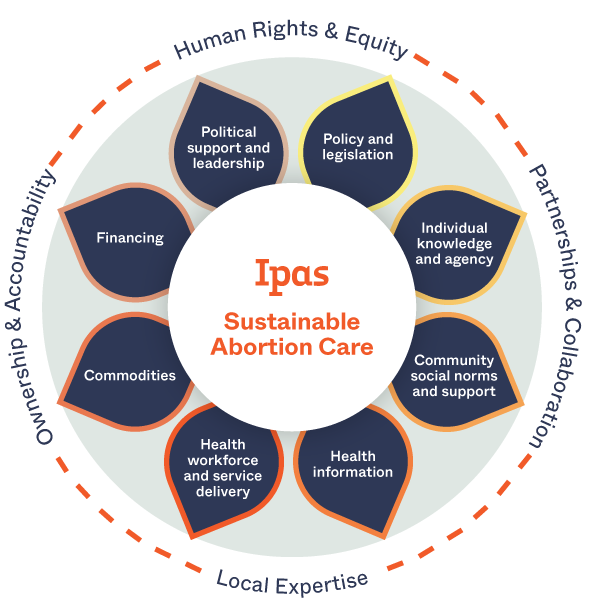Last reviewed: October 1, 2022
Key Information
- Vacuum aspiration is effective and safe, with success rates over 98% and major complication rates under 1%.
Quality of evidence: High
Effectiveness
A successful vacuum aspiration requires no further intervention to evacuate the uterus. In a large United States-based observational study of 11,487 first-trimester aspiration abortions done by physicians, nurse practitioners, certified nurse midwives and physicians assistants, the need for repeat aspiration due to incomplete abortion was 0.28% and ongoing pregnancy was 0.16% (Weitz et al., 2013).
Safety
A 2015 systematic review analyzed 57 studies reporting data for 337,460 aspiration abortions performed before 14 weeks gestation in North America, Western Europe, Scandinavia and Australia/New Zealand (White, Carroll, & Grossman, 2015). Major complications requiring intervention (such as hemorrhage requiring transfusion or perforation necessitating repair) occurred in ≤ 0.1% of procedures; hospitalization was necessary in ≤ 0.5% of cases. Studies looking at different cadres of providers (physician assistants, nurses, nurse midwives, etc.) in other settings have had similar results (Hakim-Elahi, Tovell, & Burnhill, 1990; Jejeebhoy et al., 2011; Warriner et al., 2006; Weitz et al., 2013). In two studies that compared newly trained midlevel providers to experienced physician providers (Jejeebhoy et al., 2011; Weitz et al., 2013), there were no observed differences in abortion success or complication rates.
A retrospective cohort study conducted in the United States compared rates of procedural complications during outpatient aspiration abortion through 13 weeks and six days gestation in women with at least one medical comorbidity (diabetes, hypertension, obesity, HIV, epilepsy, asthma, thyroid disease and bleeding/clotting disorders) to women without comorbidities. The overall rate of complications—which included uterine perforation, blood loss greater than 100mL, cervical laceration and retained products of conception that required reaspiration—was 2.9%; there was no difference between the two groups (Guiahi et al., 2015). Two retrospective cohort studies, that together included 5,288 aspiration abortion procedures performed before 13 weeks gestation, found no differences in complication rates between obese, overweight, and normal weight women (Benson et al., 2016; Mark et al., 2017).
Mortality
In the United States, the mortality rate from all legal induced abortion between 2013-2018 was 0.41 deaths per 100,000 reported abortions; mortality rates disaggregated by abortion type or length of pregnancy are not available (Kortsmit et al., 2021). In comparison, during the period from 2007-2016 the mortality rate from live birth in the United States was 17 deaths per 100,000 live births (Creanga et al., 2017; Petersen et al., 2019). A secondary data analysis that compared mortality rates associated with live birth to those from legal induced abortion in the United States found that the risk of death from childbirth was 14-fold higher than the risk of death from abortion (Raymond & Grimes, 2012). In the 2015 systematic review about the safety of vacuum aspiration in multiple countries referenced above, no deaths were reported (White et al., 2015).
| Upadhyay, 2015 | Weitz, 2013 | Jejeebhoy, 2011 | Warriner, 2006 | Hakim-Elahi, 1990 | |
| Number of women included | 34,744 | 11,487 | 897 | 2,789 | 170,000 |
| Location | USA | USA | India | South Africa and Vietnam | USA |
| Provider type | Not specified | Experienced physicians and newly trained nurse practitioners, certified nurse midwives and physician assistants | Newly trained physicians and nurses | Experienced physicians, midwives and doctor-assistants | Experienced physicians |
|
Time period
|
2009-2010 | 2007- 2011 | 2009-2010 | 2003-2004 | 1971-1987 |
| Total minor complication rate | 1.1% | 1.3% | 1% (all reported as incomplete abortion) | 1% | |
| Incomplete abortion | 0.33% | 0.3% | 1% | 0.9% | Not reported (0.35% re-aspiration rate) |
| Ongoing pregnancy | 0.04% | 0.16% | Not reported | Not reported | 0% |
|
Minor infection
|
0.27% | 0.12% | Not reported | 0.1% | 0.5% |
| Total major complication rate | 0.16% |
0.05% (6 complications: 2 perforations, 3 infections and 1 hemorrhage) |
0.12% (1 complication: 1 high fever) |
0% | 0.07% (hospitalizations for perforation, ectopic pregnancy, hemorrhage, sepsis or incomplete abortion) |
| Death | 0% | 0% | 0% | 0% | 0% |
Who can perform vacuum aspiration?
The World Health Organization (WHO) makes service delivery recommendations for the provision of uterine aspiration, which includes assessment of gestational age, cervical preparation if needed, the procedure itself, pain management including the provision of a paracervical block, and the assessment of procedure completeness through visual examination of the products of conception (WHO, 2022). Health workers with the skills to perform transcervical procedures and bimanual examinations to diagnose pregnancy and determine gestational
age based on uterine size can be trained to perform vacuum aspiration. WHO advises that uterine aspiration is within the scope of practice for specialty and general medical practitioners, and recommends the provision of vacuum aspiration by associate and advanced associate clinicians, midwives, and nurses based on moderate certainty evidence of safety and effectiveness. Traditional and complementary medicine professionals are recommended to provide uterine aspiration based on low certainty evidence of safety and effectiveness, and WHO suggests that auxiliary nurses and auxiliary nurse midwives may be able to perform aspiration in settings where they provide basic emergency obstetric care (WHO, 2022). For further information about health worker roles in abortion care, see Appendix: World Health Organization recommendations for health worker roles in abortion care.
